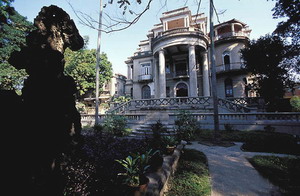|

Before the Opium War
In history, Gulangyu once is a sparsely inhabited desert island. Till the Song and Yuan Dynasties, there had the name of "Yuan Sha Zhou". In the Ming Dynasty the name "Gulangyu" was used. There is mostly half-fish and half-agriculture economy on the island, the original houses were mostly very miserable folk-houses.
Original folk-inhabitancy styles in the South-Fujian Triangle Area naturally affect the folk-houses styles. Therefore, before foreigners entered Gulangyu, there was no difference between the island's houses and the folk-houses in the South-Fujian Triangle Area. This style can be still seen in well-reserved village. Even on the modern Gulangyu island, there still exists the ancient building groups.
1843-1902 Western Architecture Emerging
From the Late-Ming and Early-Qing Dynasties to the Opium War, Gulangyu's architecture began to evolve. After Xiamen became the treaty port, foreign colonialists came to Gulangyu to stay or settle down one after another. Gulangyu became the first-choice location to develop.
Gulangyu has the excellent geology, climate, landscape condition, suitable for residence. Therefore, till nowdays, 90% of Gulangyu's buildings are resident buildings. Foreignes poached on Gulangyu, first hired the folk-houses to implement the power to manage hospitals, churches, schools; when strength enhanced, could stand firm, began to build the missionary schools, missionary hospitals, churches, missionary book-house, consulates. Certainly, most of buildings are still resident buildings of mansions, villas, etc.
A lot of overseas Chinese, who went abroad to make a living in early years, came back to ancestral home of South-Fujian after succeeded, took Gulangyu as best foothold, invested on the island one after another, and build a lot of mansions and annexes. Many buildings' scale is grand, overtook the foreigners', cost was very expensive, often select the top-grade architecture materials and techniques. Nowadays, on Gulangyu these mansions and annexes are remade by the government for public use.
Twenties to Thirties of the 20th Century
On Gulangyu, there spread all over different styles of architecture. Among those, about 70% were built in the twenties to thirties of the 20th century. Except for foreigners and the overseas Chinese, the local residents also erected and built their houses and homes. Some local celebrity and rich men often employed foreign designers to design paper, or copied ready-made paper, or imitate surrounding house-styles to build houses; the completed residencies generally are grand in scale, magnificent in decoration, exquisite in works, well-done in making.
Apart from resident buildings, some overseas Chinese also invested to build many public utility buildings, established architectural companies, organized a construction group, developed and constructed a lot of blocks and shops. The well-known overseas Chinese industrialists, Huang Yizhu, Li Qingquan, Huang Zhongxun, etc, invested a lot to develop real estate, constructed and sold houses, set up telephone and telegram companies as well as water-supply factories, wharfs, and this kind of public utilities. Before Anti-Japanese War, Gulangyu's houses strew orderly with alien style. During the anti-war and China's War of Liberation, some houses were destroyed to various degrees.
After liberation, Xiamen Municipal and Gulangyu District people's government took over partial large buildings, through modification and decoration, a part of which became public utilities. For example, original enormous "White House Style" building----Lin Heshou's "Eight-Diagram Building" converted into Gulangyu Organ Museum. A lot of big-scale mansions, villas with carelessly created styles, after several times of careful decoration and modification, have become multi-function, meaningful, landmark buildings.
|
|